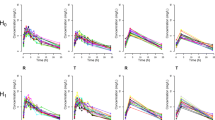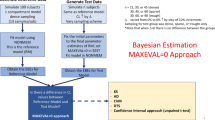Abstract
Analyses of simulated data from pharmacokinetic/pharmacodynamic (PK/PD) studies varying with respect to the amount and timing of observations were undertaken to assess the value of these design choices. The simulation models assume mono- or biexponential drug disposition, andE max-type pharmacodynamics. Data analysis uses a combined PK/PD population analysis or a hybrid, individual-PK/population-PD analysis. Assuming that the goal of the PK/PD studies is to estimate population PD, performance of designs is judged by comparing the precision of estimates of population mean PD parameters and of their interindividual variability. The simulations reveal that (i) PK data, even in small number (2 points per person from as few as 25–50% of persons) are very valuable for estimating population PD; (ii) designs involving more individuals, even if many are sparsely sampled, dominate designs calling for more complete study of fewer persons; (iii) the population analysis is generally superior to the hybrid analysis, especially when the PK model is misspecified (biexponential assumed to be monoexponential for analysis); (iv) varying sampling times and doses among subjects protects against the ill effects of model misspecification. In general, the results are quite encouraging about the usefulness of sparse data designs to estimate population dose response.
Similar content being viewed by others
References
L. B. Sheiner and L. Z. Benet. Premarketing observational studies of population pharmacokinetics of new drugs.Clin. Pharmacol. Ther. 38:481–487 (1985).
R. Temple. The clinical investigation of drugs for use by the elderly: Food and drug guidelines.Clin. Pharmacol. Ther. 42:682–685 (1987).
J. L. Steimer. Estimating interindividual pharmacokinetic variability. In M. Rowland, L. B. Sheiner and J. L. Steimer, (eds.),Variability in Drug Therapy, Raven, New York, 1985, pp. 65–109.
S. L. Beal and L. B. Sheiner. Methodology of population pharmacokinetics. In E. R. Garrett and J. L. Hirtz, (eds.),Drug Fate and Metabolism, Vol. 5, Marcel Dekker, New York, 1985, pp. 135–183.
C. Peck, J. Collins, and J. Harter. Incorporation of pharmacokinetic and pharmacodynamic intelligence into early drug development (abstract).Clin. Pharmacol. Ther. 47:126 (1990).
L. B. Sheiner and S. L. Beal. Evaluation of methods for estimating population pharmacokinetic parameters. III. Monoexponential model: Routine clinical pharmacokinetic data.J. Pharmacokin. Biopharm. 11:303–319 (1983).
M. K. Al-Banna, A. W. Kellman, and B. Whiting. Experimental design and efficient parameter estimation in population pharmacokinetics.J. Pharmacokin. Biopharm. 18:347–360 (1990).
M. Gibaldi and D. Perrier.Pharmacokinetics, 2nd ed., Marcel Dekker, New York, 1982.
D. Verotta and L. B. Sheiner. Simultaneous modelling of pharmacokinetics and pharmacodynamics: An improved algorithm.Comput. Appl. Biosci. 3:345–349 (1987).
G. E. P. Box and M. E. Muller. A note on the generation of random normal deviates.Ann. Math. Statist. 29:160–161 (1958).
P. Lewis, A. Goodman, and J. Miller. A pseudorandom number generator for the system 360.IBM Syst. J. 8:135–146 (1969).
S. L. Beal. Population pharmacokinetic data and parameter estimation based on their first two statistical moments.Drug. Metab. Rev. 15:173–194 (1984).
S. L. Beal and L. B. Sheiner.NONMEM Users Guides, NONMEM Project Group, UCSF, San Francisco, CA, 1989.
H. A. Akaike. A new look at the statistical model identification.IEEE Trans. Autom. Control 19:716–723 (1974).
R. A. Becker and J. M. Chambers.S. An interactive environment for data analysis and graphics, Wadsworth, Belmont, CA, 1984, pp. 447–448.
D. M. Steinberg and W. G. Hunter. Experimental design: Review and comment.Technometrics 26:71–98 (1984).
L. Endrenyi. Design of experiments for estimating enzyme and pharmacokinetic parameters. In L. Endrenyi (ed.),Kinetic Data Analysis, Plenum Press, New York, 1981, pp. 137–167.
P. J. Bickel and A. M. Herzberg. Robustness of design against autocorrelation in time I: asymptotic theory, optimality for location and linear regression.Ann. Statist. 7:77–95 (1979).
P. J. Bickel, A. M. Herzberg, and M. F. Schilling. Robustness of design against autocorrelation in time II: optimality, theoretical and numerical results for the first-order autoregressive process.J. Am. Statist. Assoc. 76:870–877 (1981).
Author information
Authors and Affiliations
Additional information
Work supported in part by U.S. Department of Health, Education and Welfare, Grants GM26676, GM26691.
Rights and permissions
About this article
Cite this article
Hashimoto, Y., Sheiner, L.B. Designs for population pharmacodynamics: Value of pharmacokinetic data and population analysis. Journal of Pharmacokinetics and Biopharmaceutics 19, 333–353 (1991). https://doi.org/10.1007/BF03036255
Received:
Accepted:
Published:
Issue Date:
DOI: https://doi.org/10.1007/BF03036255




